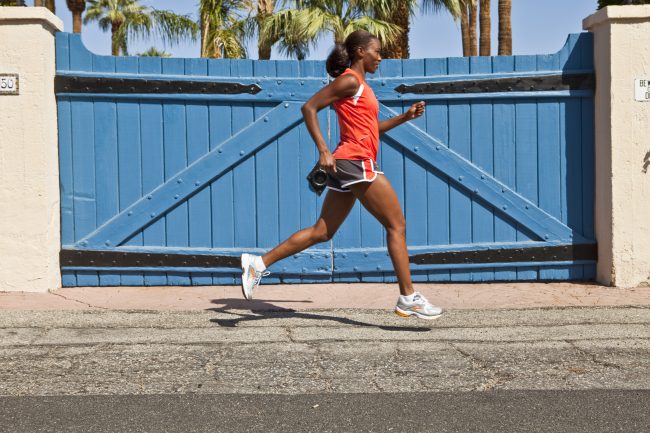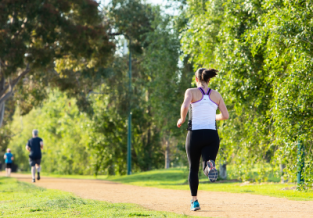First Time 10K Runner
Published on
23 Aug 2019


Written by
Kate Senini
Consultant Physiotherapist
Call us on: (03) 9975 4133
Have you just completed a 5km running event and have the itch to run a longer distance? The vibe and atmosphere amongst these events can really inspire you and your running, and after smashing out a 5km, the next to tick off the list is usually a 10km.
With running season in full swing, it is important for beginner runners to know the differences and some key guidelines of running 10km in comparison to a 5km distance.
What Are The Differences Of A 5km And 10km Run?
Your body’s muscles need to have a higher level of strength and fitness level in order to complete a 10km run with no injuries. For example, calves are very important for shock absorbing and pushing off when running, and though you may have had enough strength for a 5km, 10km is another kettle of fish! Ensuring you add in some strength training will not only improve your running, but also help to reduce overload injuries.
Running technique becomes even more important with longer distances, as with poor biomechanics and technique, your efficiency and risk of injury can be affected. The repetitive nature of running as well as poor technique is a recipe for disaster in regards to injuries and improvements.
With the increased distance of the event, the kilometres covered in training also increases. This ultimately means more time. For a first time 10km runner who has only ever done 5km runs, building up your program slowly with multiple runs per week is crucial to help your body prepare for the distance.
Now that you are running a longer distance, it would be worth adding in some interval training and running drills to build speed and strength, rather than merely lots of long, slow runs. A rough guide for a 10km run would be to start on an interval session of 20 minutes and build this up to 30 minutes, with interval sessions such as 6 x 1 minute and 5 x 2 minutes, at a pace around 10-15 seconds faster than your long slower runs.
The Do’s And Don’ts Of Progressing From 5km To 10km
Do…
Find a running partner or group.
Keeping motivated to stick to your training program can sometimes be hard.
By finding a running partner or joining a running group, the normal “I’m tired” excuses won’t be as acceptable! Additionally, running groups are often run by physios or by coaches, and thus can also be very informative and beneficial from an anatomical perspective. A good example is RunFix owned by our Physiotherapist David Palmer
Increase core and lower limb strength.
Completing Clinical Pilates or going to the gym for general lower limb strength can help build the muscle strength required to cross over into your running endurance, building speed and helping to prevent injuries. Rehabilitation Classes are an excellent way of targeting any strength deficits that need to be addressed.
Taper your training in the final week.
One week before a 10km race should be enough to let your body recover, ensuring that it is refreshed and ready for the actual competition day. Keep the speed the same but reduce your total amount of km’s for the week – roughly 50% less.
Ensure you have updated your shoes.
Running more kilometres per week in preparation for a 10km event will obviously be a lot more mileage than a 5km. This means that the support and shock absorption in your shoe will reduce faster, meaning you may need to update them sooner depending on how much training is completed. There are some really nice set ups in shoe shops or even physio clinics, that do running assessments who can tell you what sort of shoe would suit your foot type and running style the best.
Alternatively, Sole Motive in Melbourne is a great example of this in the CBD here in Melbourne where they complete running assessments on a treadmill to help find the right shoe for your biomechanical needs.
Don’t…
Increase your km’s too quickly in training.
Slowly increasing your kilometres each week is vital in letting your body adapt and cope with the load that it is enduring. Most weeks you should aim to increase your total running kilometres by about 10%. However, every few weeks you should have a taper week where you reduce the total kilometres, which actually helps in allowing your body to refresh and adapt to the load.
Push through an injury in training.
Many people often try to ‘tough out’ niggles and injuries and push on with their running to try and stay on schedule. However, it is best to get on top of things early to avoid niggles turning into more chronic injuries that will decrease your performance, not only in training but also for your event. Seeking a medical professionals opinion early can really help to nip it in the butt before it really hits its peak, ensuring you are not sidelined for too long. Our team of Physiotherapists have up to date knowledge in running biomechanics, identifying the causes of your niggles, and helping you get on top of it as quickly as possible.
Lose motivation half way through training.
Losing motivation and routine within your running, and then cramming close to the event can exponentially increase your risk of injury, and hinder your performance. It is best to keep your running as consistent as possible, so that your body can gradually accommodate to, and get used to the load. Having a big break does not only reduce your cardiovascular fitness, but will also overload your joints and muscles very close to your event when you should be tapering.
Forget to stretch.
Stretching becomes even more critical when you are running longer distances and more kilometres per week. Your muscles are working a lot more, and will naturally tighten with time if you don’t stretch or release them. This tightness can lead to injury, as a tight muscle can’t function properly, and can tug on the bone where it inserts. Stretching is a great way to release these muscles and prevent injury. Alternatively, remedial massage (link) or self-release with a foam roller can be extremely effective.
But most of all – have fun! Following this advice will lead you to be cruising through the 10km mark & preparing for a 15km run, and if you have any questions or queries at all the team at Pure Physio will do our very best to help you out.
Happy running!
About the Author
Kate Senini — Consultant Physiotherapist
Kate, who was a founding partner at Pure Physio in 2010, is now working exclusively in a clinical role. Helping people recover from injury and prevent future injuries has always been her true passion!


